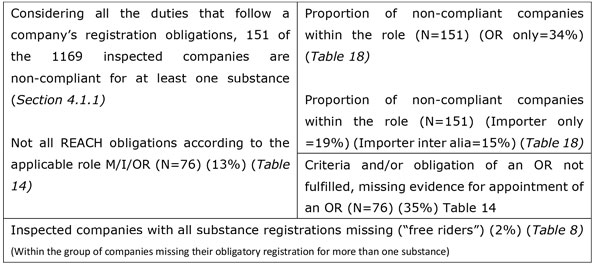Analysis of the Final Report on the Third REACH-EN-FORCE Project: Advice on REACH Supply Chain Compliance
Recently, ECHA published the final report of the third REACH-EN-FORCE (REF) Project. REF3 covered 28 countries, with 1,169 companies and 5,746 substances inspected during 2013-2014. Detailed investigations during phase 2 of the project revealed that only representatives (OR) and importers are more at risk of non-compliance than manufacturers of substances.
As is described by ECHA, “The project was coordinated by ECHA’s Enforcement Forum and implemented in close cooperation with national customs authorities.” A total of 104 ORs were inspected and a third of them (32 %) did not comply with their specific OR information duties as described by Article 8 of REACH. The investigation revealed that the supply chain data (e.g. tonnage coverage) collected from importing downstream users was regularly inconsistent with the information provided by the OR.
“The flow of information in the supply chain between only representatives and importing downstream users was poor. It was often difficult to establish the structure of the supply chain as the respective importers could not specify the correct only representative and the only representatives did not keep reliable records of represented importers.”
The table below summarizes some of the key non-compliance issues noted in the report.
Key Non-Compliance Issues:

Having successfully completed 2 inspections by the Irish national authorities, we would like to describe our efforts to assist downstream users (DU) in the EU to achieve compliance. To fulfil our obligations under Article 8 of the REACH Regulations, REACH24H designed and developed a secure online IT tool, the REACH Supply Chain Compliance System (RSCC System) in 2010. The purpose of the RSCC System was to efficiently manage the REACH information communication between global supply chain actors (non-EU manufacturer (NEM), importing DU, non-EU distributor (NED)) and OR.
Based on the practical experiences of the first inspection phase of the third REACH-EN-FORCEREF3 in 2013, REACH24H upgraded the system (NEW REACH Supply Chain Compliance System (NEWRSCC)) in advance of the second inspection phase. We received very positive feedback from the inspector about the functionality of the system and how NEMs, NEDs and importing DUs were able to effectively access REACH compliance documentation (Confirmation letters, REACH compliance tonnage coverage certificates, SDSs, etc.) using this tool. Therefore, we formally released the NEWRSCC in January 2015.
After using the NEWRSCC for one year, our clients have experienced increased efficiency in the access to and management of all REACH compliance documentation. All actors in the supply chain, including NEM, NED and importing DU can review and download REACH documentation in their own accounts. The automatic monitoring of the tonnage volume for each specific substance in the relevant tonnage band also enables the importing DU to download REACH compliance tonnage coverage certificates without delay.
How to utilize the NEWRSCC to optimize your REACH compliance?
We believe the NEWRSCC is already implementing some of the key recommendations noted in the REF3 report to “define an explicit duty for a documented contact/exchange of information between the importing DU and the OR” as follows:
• explicitly defining the duty for an importing DU to keep a documentation for the relevant substance(s) with annual tonnages confirmed by the OR(s) (e.g. keeping confirmation documents from the related ORs).
When included in the DU list of your non-EU supplier(s) (manufacturer or distributor) in the NEWRSCC, you may connect with several suppliers from one account. All the tonnage coverage records and related REACH compliance tonnage coverage certificates will be available in your NEWRSCC account which you are able to securely access at any time.
• stipulate that only an importing DU keeping such documentation is released from the registration duties of an importer.
Being included in the DU list alone does not release an importer from their registration duties; to achieve this please follow these steps: (i) Ask your supplier to input tonnage records in the NEWRSCC. (ii) Verify and confirm the tonnage information entered by your supplier (iii) Verification by the OR releases the REACH compliance tonnage coverage certificates in your NEWRSCC account for you to download and retain for any inspections.
• Define a new duty for the OR to send the information on covering the registration duties for the importing DU for a specific substance and the information about the related annual quantities of the substance imported according to its lists (i.e. the tonnages covered by the OR) to the importing DU.
We provide a REACH registration ‘Confirmation Letter’ to the supplier that details the specific substance(s), CAS number, tonnage volume and (pre-) registration number (if permitted) together with our contact information. The supplier can then provide a copy to any potential EU importer customer with the advice to contact us so we can begin the process of adding them to the DU list and issuing documentation to release them from their registration obligations.
Further point to note from the report is:
For the import of mixtures, the importers will also need to know what quantity of the substance in a mixture is covered by an OR registration, as they would otherwise be subject to a registration requirement themselves.
Check List for Importing DUs – Have you received these documents from suppliers / OR?
|
|
|
|
|
|
* According to the Article 31(7) of REACH regulation, any actor in the supply chain who is required to prepare a chemical safety report according to Articles 14 or 37 shall place the relevant exposure scenarios (including use and exposure categories where appropriate) in an annex to the safety data sheet covering identified uses and including specific conditions resulting from the application of section 3 of Annex XI. In Article 14 it is stated that if the substance meets the criteria for classification as dangerous in accordance with Directive 67/548/EEC or is assessed to be a PBT or vPvB, the chemical safety assessment shall include the exposure scenarios, exposure assessment and risk characterization. So for the substance meets the criteria for classification as dangerous in accordance with Directive 67/548/EEC or is assessed to be a PBT or vPvB, the exposure assessment is required, and then the exposure scenarios should be placed in annex to the safety data sheet.
In summary, active communication between the importing DU and OR is essential. As the OR may be appointed by many NEMs and the importing DU may have suppliers, using a secure online IT tool like the NEWRSCC System facilitates effective REACH compliance administration.
If you’re interested in more details about this topic, please send your queries directly to customer@reach24h.com .


